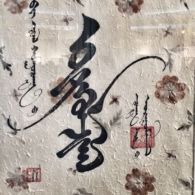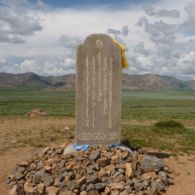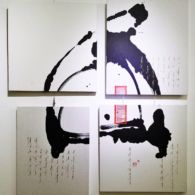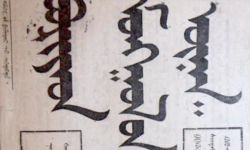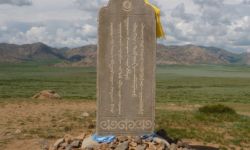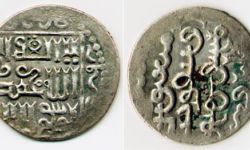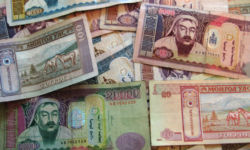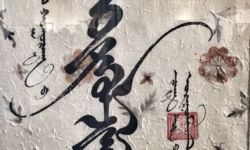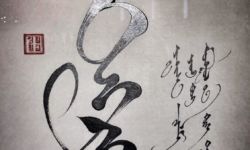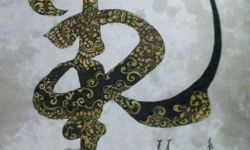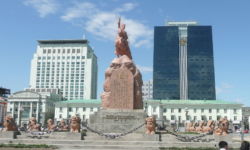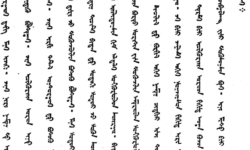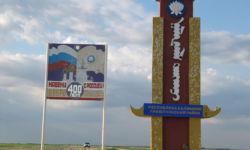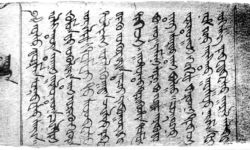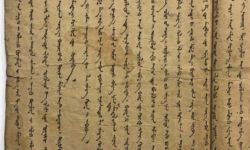Profile
Classical Mongolian is one of the great imperial scripts – the script of an empire that once stretched from the Pacific to the Mediterranean, the largest contiguous land empire in history. By the end of World War II, though, it was no longer used officially even in Mongolia.
It had its roots, aptly enough, in a military victory (or, to look at it another way, a military defeat) in 1203, when Genghis (or Chinggis) Khan defeated the Naimans (a group of Turkic tribes living in Central Asia) and captured their scribe, Tatar-Tonga. Tatar-Tonga was induced to create a script for the great Khan, and to do so, he adapted a script with a fascinating, even geometrical history: the Old Uyghur alphabet.
Let’s go still further back into history – to biblical times, in fact. The lingua franca of what we now call the Middle East was Aramaic. At the eastern borders of Aramaic, in modern Iran, the script evolved into Sogdian, a script that first appeared around the fourth century and was initially used to write letters and inscriptions. A cursive form of Sogdian was used in secular documents, royal proclamations and Buddhist and Manichaen manuscripts.
Over time, and still further east, Sogdian morphed into the Old Uyghur alphabet, but something fascinating happened in the process – something that fundamentally defines the Mongolian script: it turned through 90 degrees.
Sogdian was written from right to left in horizontal lines, but its offspring, the Old Uyghur alphabet, was written from left to right in vertical columns. We don’t know why this happened, any more than we know why the Phoenician alphabet turned through 90 degrees when adopted by the ancient Greeks. It may have been to imitate Chinese writing; it may have been to pay homage to Tengri, the sky god; it may have had something to do with some aspect of convenience that no longer occurs to us, accustomed as we are to writing on flat, level surfaces or geometrical screens. But the result of this twist, and the Mongol victory over the Naimans, was that soon the whole of Asia would see a vertical script, the Classical Mongol script, known in Mongolian as bichig.
One of the many fascinating features of bichig is that it has what might be thought of as a built-in calligraphic quality. Each letter has three forms: initial (used when it comes at the beginning of a word), medial (used when it comes in the middle of the word) and final (we’ll leave you to guess what that means). In almost every case, both the initial and final forms have a certain flourish, while the medial tends to be simpler and more contained. The effect is to allow the writer to start each word with a kind of fanfare, and to sign off with a swoosh. We’ll come back to this later in this entry.
Over the centuries, of course, the Mongol empire was eroded by civil war and division. By 1400 both China and the territories in the west had largely been lost, and the Mongols retreated to Mongolia. In the seventeenth century, the country was overtaken by the Manchu-founded Qing dynasty, which ruled Mongolia until the collapse of that dynasty in the early twentieth century. No sooner had Mongolia achieved independence, however, than it came under the influence of the Soviet Union, which imposed the Cyrillic script on all its domains. By the time a peaceful revolution took place in 1990, the traditional bichig script had been all but forgotten, though it had survived to some extent in what had become the Inner Mongolia Autonomous Region of China.
It is a testimony to the striking graphic qualities of the Mongolian script that its revival is being led by artists, designers, calligraphers and poets. Mongolian calligraphy in particular is gaining respect and visibility in the global landscape of calligraphy, especially since 2013, when the art form was inscribed on the UNESCO List of Intangible Cultural Heritage in Need of Urgent Safeguarding. Individual works of calligraphy are increasingly being used in fashion design, interior design and tattooing.
The Mongolian script is still used, to some extent, in outposts of Mongol culture, such as two of the Russian federal republics: Buryatia, on the shores of Lake Baikal and sharing a border with Mongolia; and Kalmykia, on the shores of the Caspian Sea. The Kalmyks suffered dreadfully in World War II: the killing of a large fraction of the Kalmyk population and the destruction of their society as consequences of deportations, along with the subsequent imposition of Russian as the sole official language, have meant that only the elderly have a fluent command of Kalmyk, and still fewer use the traditional bichig script.
In 2020, though, the Mongolian ministry of education, culture, science and sports announced that the traditional vertical script would return to use by 2025. In the “comprehensive restoration” of the alphabet, scientific, literary and state registry offices have been asked to establish a system for Mongolian names, information and communication technologies are required to adapt traditional Mongolian to the “electronic environment,” schools must allow more time to teach the script and cultural centres will be set up to promote the Mongolian written heritage.
This move is in sharp contrast to the situation in Inner Mongolia, where the Chinese government has announced that the Chinese language and script will be introduced in the name of “bilingual education”—potentially a first step toward replacing the rich and ancient Mongolian language traditions in the name of national unity.
You can help support our research, education and advocacy work. Please consider making a donation today.
Links
General Script, Language, and Culture Resources
- Omniglot (Mongolian)
- Omniglot (Kalmyk)
- Wikipedia (Mongolian)
- Wikipedia (Kalmyk)
- Learn World Alphabets App
- Study Mongolian
- Ancient Scripts Mongolian
- Brief History of Mongolian Script
- Making Sense of the Traditional Mongolian Script
- Case Study of the Kalmyk Language
- Scriptsource (Mongolian)
- Scriptsource (Kalmyk)
- Alibris Mongolian Books
- Mongolian Language New Testament
- Video on efforts to revive the Mongolian script in Buryatia (in Russian)
Community Resources
- Kalmyk Project Facebook
- Mongolia LIVE Facebook
- Mongolia Script Facebook
- Mongolian activities, events, history and travel
- Blog about current events in Mongol culture
- Mongolian script revival in ethnic Buryatia
Font/Keyboard Resources
Gallery
Sponsor
“The great nomadic heritage is freedom coupled with close family ties, bonds created while stewarding the land — the space of which acts as a background enabling deep connections made possible only by much movement… together.”
—Ashira Malka
Sponsor
“To Haji Noor Deen whose blend of Chinese and Arabic calligraphic traditions deepened my early obsession with language and scripts.”
—Erin McConnell
Sponsor
“For Eric, who made my pursuit of all things language so much easier.”
—Margaret Ransdell-Green


